Hasan and Mary Smith stand cheek to cheek outside their newly rehabbed home in the Chicago Lawn neighborhood of Chicago on Sept. 11, 2019. The home is one of dozens of "reclaimed" houses and apartment buildings that became vacant during the mortgage crisis that began in 2008. Hasan and Mary met five years ago at a grocery store. Drawn to her talkative, upbeat nature, Smith told a friend, "That's gonna be my girl." (AP Photo/Martha Irvine)
The Associated Press
CHICAGO (AP) - Many know the violent repute of parts of this city, the shootings, gangs, forgotten main streets and residential blocks plagued with boarded-up houses and apartment buildings.
Chicago Lawn on the city' South Side was once all that; its streets were littered with abandoned homes, especially after the 2008 mortgage crisis took hold. 'œIn some blocks, it looked like a war zone,'ť said the Rev. Anthony Pizzo, then a priest at St. Rita of Cascia Catholic church, a rare neighborhood mainstay.
But then, a feisty core of residents banded together to save this place.
They are doing so with an unexpected mix of people in an often-segregated city, with neighbors who don't always speak the same language, practice the same religion or trust one another. They are African Americans, Hispanic immigrants, Muslims, Catholics, Jews - and 'œreturning citizens,'ť men fresh from prison, like Hasan Smith, a former gang member who served nearly three decades for shooting and killing a man in a drug-related crime. He was just 19 at the time.
'œI told myself when I get there, I'm going to be running, moving forward,'ť said Smith, who came to Chicago Lawn in 2006 in search of a second chance and who helped rebuild a home that is the first he and his wife, Mary, have ever owned. Many others are doing the same, moving into rehabbed bungalows and apartments.
And sparking nothing short of a Chicago Lawn renaissance.
Decades earlier, the Rev. Martin Luther King Jr. marched into what was then an ethnic-white neighborhood to demand fair access to housing for African Americans who'd been limited to slums by redlining. Met by angry white protesters, King was struck with a rock and temporarily deterred.
The racial makeup of the neighborhood began to shift as many whites left the South Side. By the 1990s, Chicago Lawn was tipping to majority African American with a Hispanic contingent that also steadily grew. Many who came here were first-time homebuyers, a trend that only grew as the housing market boomed.
But because of language barriers or confusion over loan terms, such as adjustable rates, many were perched precariously on the edge of the housing bubble when it burst in 2008. Some with lower credit scores also had received subprime loans with high interest rates.
Pizzo joined organizers from a neighborhood organization, the Southwest Organizing Project, or SWOP, as they called for bank protests in 2009, ultimately working with the banks through repayment, credit counseling and refinancing to save more than 500 individuals and families from foreclosure.
The neighborhood was a gang-ridden 'œghost town,'ť Smith recalled. But he was determined to make it work. Having converted to Islam in prison, he moved into a halfway house apartment owned by the Inner-City Muslim Action Network, or IMAN, and became the first graduate of the organization's reentry program, which teaches former prisoners work and life skills.
Eventually, he got his general contractor's license and became a construction mentor to others like him, just as the community was coming together for the next phase - rebuilding the neighborhood.
By 2012, there were at least 665 abandoned homes and apartment buildings in Chicago Lawn, counted by staff and volunteers at SWOP. They called upon outside supporters such as United Power, a large coalition of Chicago neighborhood organizations and churches, and recruited volunteer attorneys, a property developer and one large early funder, the MacArthur Foundation, also based in the city.
They would, they decided, raise funds and buy up corner properties to spark redevelopment. They would, as they put it, 'œreclaim'ť the neighborhood and started with a rally, passing the hat as attendees threw in $5, $10, maybe $20. MacArthur pledged $500,000.
Lisa Madigan, then Illinois attorney general, added $3 million from funds that Illinois, other states and the federal government received from five of the nation's largest banks accused of fraudulent foreclosure-processing tactics in Chicago and elsewhere.
Then Illinois Gov. Pat Quinn pledged $4 million more and tax credits, giving the neighborhood collective enough to leverage what they had for grants and low-interest loans.
The group began with a 20-block area in Chicago Lawn, among the hardest hit with 93 vacant buildings. The first project - a 13-unit brick apartment building - was finished in 2016.
Jamillah Rashad, now 36, and her two children were among the first to move into one of the apartments in a neighborhood from which her brother had been chased when he was in high school because he 'œdidn't belong.'ť Now for the first time in her adult life, she was putting up artwork on her walls.
'œI never sat still enough to feel like I existed in a place long enough,'ť said Rashad, who works in early childhood education.
By last year, all but eight of the original 93 properties in that first target area had been rehabbed - some by SWOP, some by IMAN and others by private developers. Of the original 665 vacant homes and apartment buildings, more than 300 are now filled, with more to come. Police data also shows that violent and property crimes in Chicago Lawn have dropped about 45% since 2008.
That success prompted Illinois lawmakers this summer to approve an additional $12 million for more rehabs - and another $3 million to bring this model to North Lawndale, a West Side neighborhood racked with violence and poverty.
The next major goal is to rebuild 'œ1,000 homes on the South Side and 1,000 homes on the West Side,'ť said Nick Brunick, an attorney and leader with United Power. As he sees it, this successful formula - also being used in places such as New York City - could help struggling neighborhoods across the country.
Hasan Smith sees his contributions as his 'œchance to give back to the community that I once destroyed.'ť He and his wife moved into their new home this fall.
____
Martha Irvine, an AP national writer and visual journalist, can be reached at mirvine@ap.org or at http://twitter.com/irvineap
Hasan Smith poses for a photo as he stands in Chicago's Bronzeville neighborhood on Oct. 29, 2019, near the former site of the demolished Stateway Gardens projects, where he grew up. Smith said that, at the time, there were few options for kids like him, so he got involved with gangs at a young age. After spending nearly 30 years in jail for shooting and killing a man, he now tries to help others escape the life of crime, as he did. (AP Photo/Martha Irvine)
The Associated Press

Hasan Smith plays a drum to welcome Catholic Cardinal Blase Cupich, of the Archdiocese of Chicago, to the city's Chicago Lawn neighborhood, June 6, 2019. Neighbors from a mix of races and religions have banded together to save their neighborhood after it was decimated by the 2008 mortgage crisis. Smith, who is Muslim, took a break from rehabbing his own home to come to the event for the cardinal. "That's a nice piece of really what's been happening around here," he said of people of many faiths and races uniting. (AP Photo/Martha Irvine)
The Associated Press
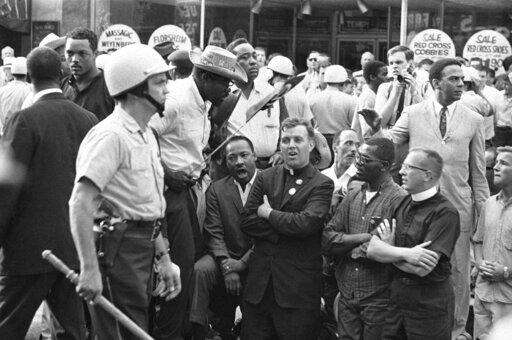
FILE - In this Aug. 6, 1966, file photo, Martin Luther King, Jr., kneeling on left, leads civil rights marchers in singing and praying in front of real estate office on Chicago Southwest Side. Neighborhoods that King visited included Chicago Lawn, where he was confronted by an angry white mob and was struck by a rock. "I have never seen, even in Mississippi and Alabama, mobs as hostile and as hate-filled as I've seen here in Chicago," King said at the time. (AP Photo/File)
The Associated Press
Jessica Garcia, left, sweeps the street in front of her new home as daughter Kayleen Garcia, age 2, stands in the foreground in Chicago on June 1, 2019. The home Garcia and her husband purchased was rehabbed by the Southwest Organizing Project, or SWOP, using funding from the state and local residents. Garcia said owning their own home was her "sueño" -- her dream. (AP Photo/Martha Irvine)
The Associated Press
People sit down for a meal during a celebration for new U.S. citizens at St. Rita of Cascia Catholic Church in Chicago on March 30, 2019. The neighborhood, known as Chicago Lawn, is an eclectic mix of Hispanic immigrants, African Americans, Catholics, Muslims and Jews. Leaders from these diverse groups have successfully worked together to bring back neighborhood, which was decimated by the 2008 mortgage crisis. (AP Photo/Martha Irvine)
The Associated Press
New U.S. citizens, many of them originally from Mexico, stand on the altar for a photo at St. Rita of Cascia Catholic Church in Chicago on March 30, 2019. The neighborhood, known as Chicago Lawn, shifted from mostly ethnic-white in the 1960s to African American and has become increasingly Hispanic since the 1990s. It has long been known as a good place for prospective homebuyers to purchase their first homes. (AP Photo/Martha Irvine)
The Associated Press
Taqi Thomas, right, patrols the streets with another member of Cure Violence in Chicago on May 22, 2019. Members of Cure Violence, formerly CeaseFire, interrupt violence in the neighborhood. Many of the interrupters are former gang members. Violent and property crimes in the Chicago Lawn neighborhood have dropped by about 45 percent since 2008, when the mortgage crisis first hit. (AP Photo/Martha Irvine)
The Associated Press
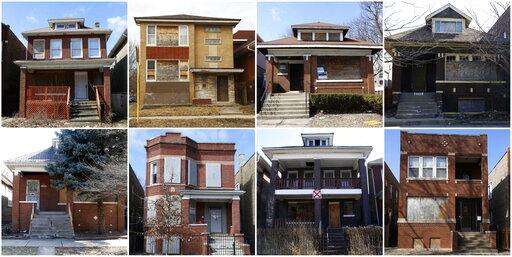
This combination of March 18, 2019, photos shows nine of about 350 vacant homes and apartment buildings that remain in the Chicago Lawn neighborhood of Chicago. Community organizations, neighbors and private developers rehabbed and "reclaimed" more than 300 vacant homes and apartment buildings since the neighborhood was hit hard by the 2008 mortgage crisis, with more to be completed. That success prompted Illinois lawmakers this summer to approve an additional $12 million to rehab more of those homes, and $3 million more to begin to bring this model to North Lawndale, among the Chicago neighborhood hardest hit with violence and poverty. (AP Photo/Martha Irvine)
The Associated Press
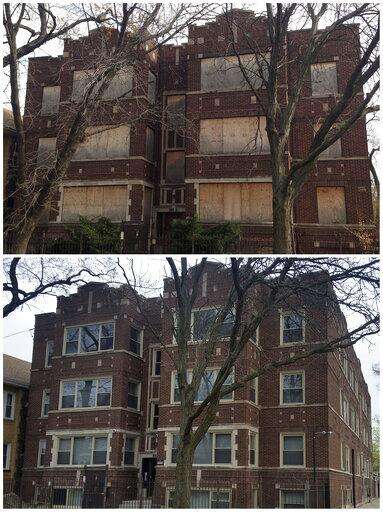
This combination of photos taken on Nov. 15, 2013, top, and again on April 19, 2016, bottom, shows an apartment building at 62nd Street and Washtenaw Avenue in the city's Chicago Lawn neighborhood. The building was the first of scores of vacant buildings that have since been rehabbed and reoccupied in Chicago Lawn. A diverse group of neighbors and community organizations have come together to help spark the renewal. (Southwest Organizing Project via AP)
The Associated Press
Hasan Smith uses a jackhammer to break up an old sidewalk next to the home in Chicago on May 30, 2019, that he and his crew rehabbed for himself and wife Mary. The previous owners lost the home to foreclosure after the 2008 mortgage crisis hit. Smith, 60, could be found working at the home most days, even when his young crew was not there. (AP Photo/Martha Irvine)
The Associated Press
Ali Rashad, right, the program manager for the Inner-City Muslim Action Network's construction program, does an inspection in Chicago on May 30, 2019, as Hasan Smith, second from right, and others watch. Much of the work was done by young men returning from prison and former gang members who are learning construction and life skills. (AP Photo/Martha Irvine)
The Associated Press
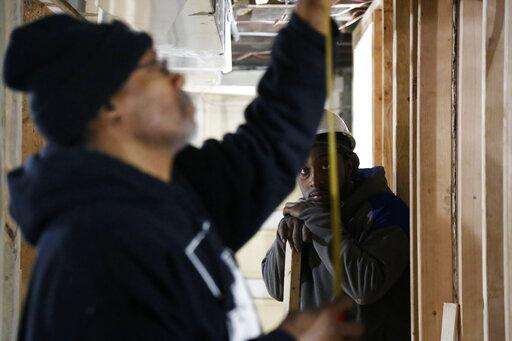
Edward "Tron" Borden Jr., right, watches as his mentor, Hasan Smith, measures ductwork at Smith's future home in Chicago on March 18, 2019. "In my world, Hasan is somebody," said the 30-year-old, who is a longtime gang member. Smith's knowledge of the streets, his past as a gang member and the fact that he's turned his life around to give back to the community after prison often give him more credibility with young men like Borden, who are part of the Inner-City Muslim Action Network's reentry program for gang members and young men who've recently been released from prison. (AP Photo/Martha Irvine)
The Associated Press
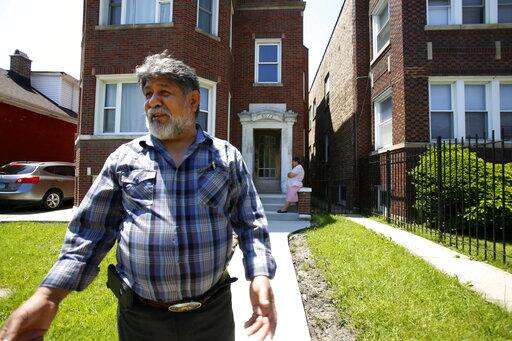
Jose Mena, 60, stands outside his apartment building in Chicago on June 2, 2019. He and wife Maria, both Mexican immigrants, moved to the Chicago Lawn neighborhood in 1990. They watched in 2008, and the years that followed, as neighbors and friends lost their homes to foreclosure. Eventually, they joined protests outside banks to help persuade them to help people refinance or come up with repayment plans. Neighborhood organizers say this pressure helped save more than 500 people from foreclosure in a neighborhood that was already filled with hundreds of vacant homes and apartment buildings. (AP Photo/Martha Irvine)
The Associated Press
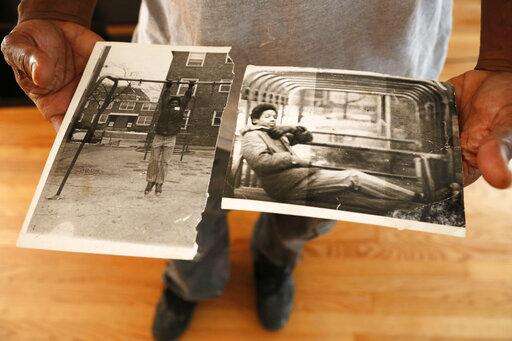
Hasan Smith holds photos on Sept. 11, 2019, that a friend took of him in 1974 for a school project in Chicago. He was 15 and already involved with gangs. Four years later, he shot and killed a man in a drug-related crime. He spent more than 27 years in prison and is now trying to make amends by mentoring young men like him and giving back to the community. On the back of the photo on the right, Smith's mother wrote: "My Baby, Son Nathaniel." Smith said his mother was deeply saddened when he went to prison but stood by him until her recent death. (AP Photo/Martha Irvine)
The Associated Press
Hasan Smith prays in the bedroom of his new home in Chicago on Sept. 28, 2019. Smith converted to Islam while in prison and serving more than 27 years for armed robbery and shooting and killing a man. He was drawn to the teaching of the Quran, the routine of daily prayers and the strong sense of community. (AP Photo/Martha Irvine)
The Associated Press
Mary and Hassan Smith, center with backs to camera, pray with well-wishers outside their newly rehabbed home in the Chicago Lawn neighborhood of Chicago on Sept. 6, 2019. The home is one of dozens that were vacant -- many of them lost to foreclosure during the housing crisis that began in 2008. (AP Photo/Martha Irvine)
The Associated Press
Hasan Smith holds the hands of his grandson, D'Angelo Brown, 2, as they listen to a band at a housewarming party in Smith's back yard in Chicago on Sept. 28, 2019. Because he was in prison, Smith missed much of the growing up of his own children. He hopes family will gather often at the home that he helped rehab for himself and his wife, Mary. (AP Photo/Martha Irvine)
The Associated Press
Hasan Smith, right, stands with Taqi Thomas, in the backyard of Smith's new home in Chicago on Sept. 28, 2019. The good friends met in the Chicago Lawn neighborhood more than a decade ago when they were residents in a halfway house apartment for men returning from prison. Both are now homeowners and giving back to the community in various ways. (AP Photo/Martha Irvine)
The Associated Press